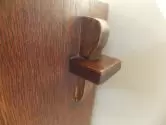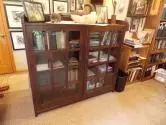Three Bookcases, Three Stories

What happens when a former literature teacher turns Arts and Crafts furniture collector?
Stickley bookcases become very desirable.
Nearly four decades ago, Mrs. Zamansky provided me with my first, a sixty-inch wide, two-door model that she and her late husband, a former University of Iowa art professor, had brought with them from upstate New York. As a budding collector with a bizarre assortment of plain brown furniture, this was the first major piece of Gustav Stickley furniture I actually had the opportunity to own. Once my shock had subsided, I confessed to her I had no idea how much her bookcase was worth.
“Don’t you worry about that,” Mrs. Zamansky assured me. “My carpenter has already told me.”
“Your carpenter?”
“Yes. I need a closet built right behind where that bookcase is and he told me it would cost $1000 to build, so that’s how much you’re going to pay me.” She paused, confidently. “And it’s worth it.”
That was 1979, and Mrs. Zamansky’s bookcase is still here in my office with me.
Several years and a couple of moves later I bought a 48” Gustav Stickley bookcase from another North Carolina collector. Like Mrs. Zamansky, he had also done his homework, but it had nothing to do with carpenters and closets. He saw what they were bringing at auction, then deducted the seller’s commission and transportation costs, and offered it to me for that price. I took it, paid in cash, and we both walked away happy.

A third situation didn’t end quite as well as the first two. By now I was living in Asheville and while not actively looking for yet another bookcase, I was intrigued by the dealer’s description: two-door, 48” wide, original finish, signed with a Craftsman paper label, and with a bonus: four keyed tenons on either side (see middle picture).
The Charlotte dealer followed his call with photographs and a firm price. The price was fair, I thought, though no yard sale bargain. I liked the keyed tenons, so I bought it over the phone. Two days later I arrived, paid in cash exactly what he had asked, and we loaded it into the back of my truck.
About six months later, the dealer called me back.
“You stole that Stickley bookcase from me,” he shouted into the phone.
“How could I?” I asked. “You named your price and I paid it.”
“Yes, but you should have told me it was worth more than that.”
“Worth more where? New York? Chicago?” I asked. “We live in North Carolina.”
“That doesn’t matter. You stole it from me.” And with that he slammed down the phone.
I stood for a moment, then turned around, looked across the room at my prized first bookcase, and sighed, “Mrs. Zamansky, I miss you.”

Until next Monday,
May you find your own Mrs. Zamansky.
Bruce
Top: Mrs. Zamansky’s bookcase.
Middle: A keyed tenon in the side of my bookcase.
